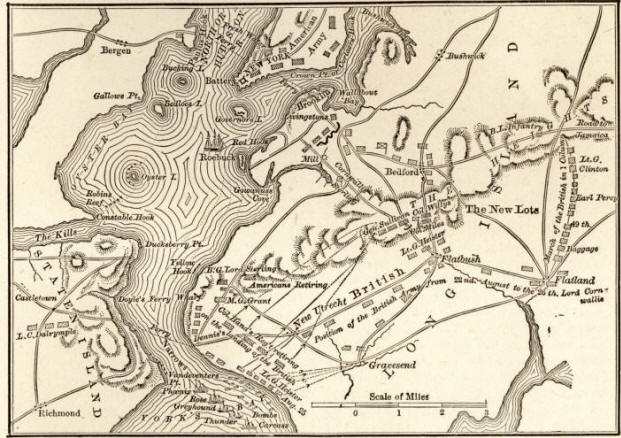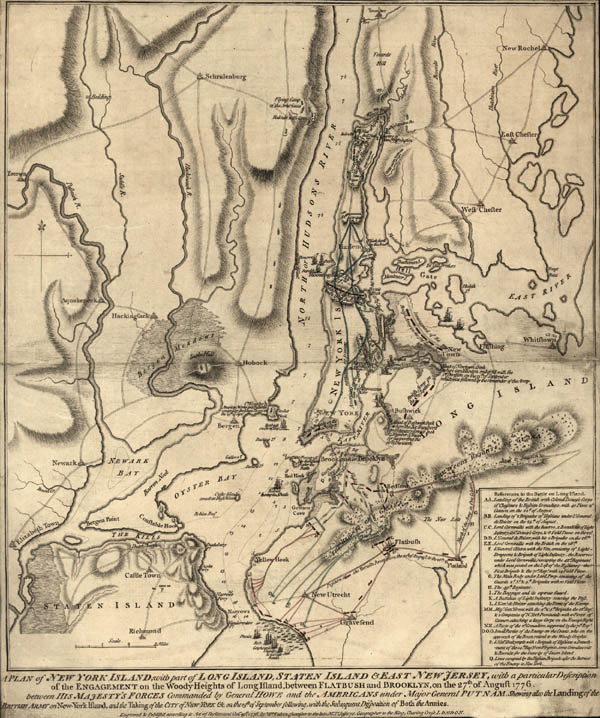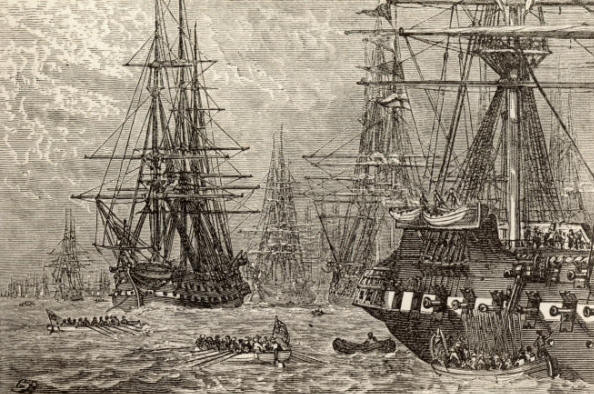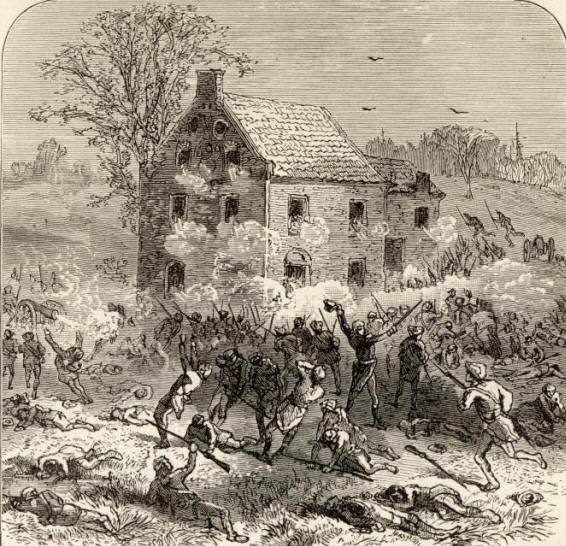Battle of Long Island
|
|
This Site:
|
Map of the Battle of Long Island
British Fleet at the Battle of Long IslandThe whole American force on the island did not exceed 8,000 men, and 2,500 of these were sent to guard the passes. On the 26th the British moved forward, under the chief command of Sir Henry Clinton and Lord Cornwallis, followed by the Germans, under General de Heister. The combined forces formed a thoroughly disciplined army. It was obvious that they intended to gain the rear of the Americans by the Bedford and Jamaica passes. At three o'clock on the morning of the 27th word reached Putnam that his pickets at the lower pass (below the present Greenwood Cemetery) had been driven in. He immediately sent General Lord Stirling with some Delaware and Maryland troops to repulse the invaders. He was followed by General Parsons with some Connecticut troops. Beyond Gowanus Creek, Stirling found himself confronted by overwhelming numbers under General Grant, with some of Howe's ships on his right flank. At the same time the Germans, under De Heister and Knyphausen, were moving to force their way at the pass farther eastward (now in Prospect Park) ; while Howe, with the main body of the British, under Clinton and Cornwallis, was pressing towards the Bedford and Jamaica passes to gain the rear of the Americans. Putnam had neglected to guard the latter pass. When, at eight o'clock, the invaders had reached those passes, not more than 4,000 men were out of the lines at Brooklyn; and, instead of ordering Stirling to fall back from almost certain destruction, he allowed Sullivan to go out with a few troops and take command at the pass below (now in Prospect Park), not nearly so important. The consequence was that, while Sullivan was fighting the Germans, Clinton had gained his rear and fell upon him. It was a surprise. Sullivan was driven back upon the Germans. After a severe hand-to-hand fight, and seeing no chance for success or an orderly retreat, Sullivan ordered his men to shift for themselves. Some fought through the attacking lines; some fled to the woods; and many were made prisoners; while Sullivan, hidden in a field of corn, was captured. Stirling and his party were now the only unbroken body of Americans in the field, and they fought with spirit four hours. Then, hopeless of receiving reinforcements, and seeing a strong body of the British approaching his flank and rear, he ordered a retreat. The bridge across Gowanus Creek (on the border of which lie was fighting, near where the old mill stood in 1850) was in flames, and his troops were compelled to wade the water and the oozy morass. Even that passage was about to be cut off by the enemy, led by Cornwallis. Quickly ordering the Delaware and Maryland troops to ford the creek and morass with some German prisoners, he, with the remainder, fought Cornwallis desperately until all the others had crossed excepting seven, who were drowned. No longer able to resist the pressure, Stirling and his men were made prisoners. The loss of the Americans did not exceed 1,000, of whom one-half were prisoners. Howe did not follow up his advantage, but allowed the American army on Long Island to retreat in safety to New York.
Stirling's last Stand at the Battle of Long IslandThis retreat was unsuspected by the British leaders on land and water until it was too late to pursue. A Tory woman living near the ferry sent her negro servant to inform the British of the retreat. He encountered a German sentinel, who could not understand a word he said, and would not let him pass. Before six o'clock (August 30, 1776) 9,000 American soldiers, with their baggage and munitions of war, excepting some heavy artillery, had crossed the East River from Long Island to Manhattan, or New York, Island. When Howe perceived this he became greatly enraged, took possession of the deserted camp, moved his army eastward, its advance being at Flushing, and prepared to seize the city of New York with the American troops in it. |
|
|
||
|
|
Site Copyright 2003-2018 Son of the South. For Questions or comments about this collection, contact: paul@sonofthesouth.net |
|
|
Are you Scared and Confused? Read My Snake Story, a story of hope and encouragement, to help you face your fears. |
||



